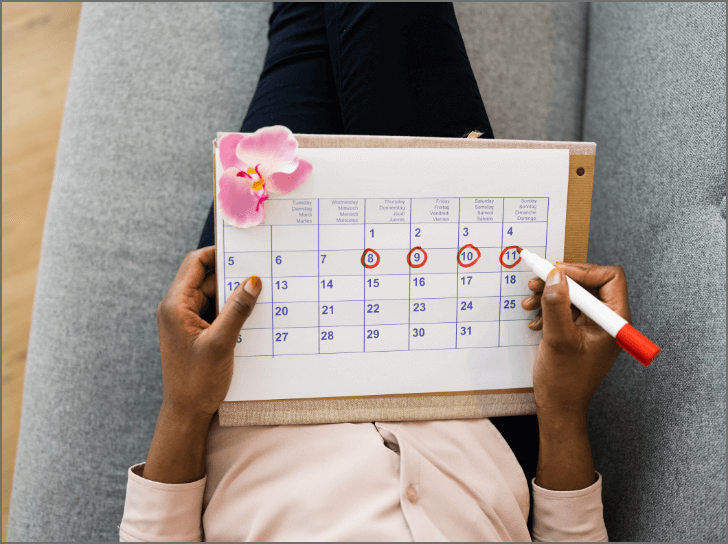
What you should know about cycle syncing
You may have come across the term “cycle syncing” in your social media feed or within women’s health news you read online. What does it mean? And is it trending for a good reason (in other words, is it just a fad or is there really something to it)? Here’s a rundown of what you should know.
Cycle syncing summarized
Cycle syncing refers to the practice of changing your daily routines and behaviors (diet, exercise, and lifestyle) to align with the phases of your menstrual cycle. It’s based on the idea that the hormonal changes that occur during the different menstrual cycle phases impact you physically and emotionally. The thinking is that, by adjusting your behaviors to accommodate the specific characteristics of each phase of your cycle, you can alleviate symptoms like cramps, bloating, and mood swings and improve your overall well-being.
Aligning behavior with menstrual cycle phases
1. Menstrual phase

- What’s going on: This is when you’re bleeding. Your uterus is shedding its lining because pregnancy hasn’t occurred. Most women bleed for 3 to 5 days, but some women may bleed as many as 7 days.1
- What you can do: During this time, your energy levels are typically low. However, exercise increases blood flow and can help reduce cramping.2 If you don’t have the energy for an intense workout, listen to your body and instead focus on rest, gentle yoga, light exercise, and meditation. Because your body loses iron during blood loss, consider eating foods that are high in iron, like lean beef, turkey, chicken, spinach, and beans.3
2. Follicular phase

- What’s going on: This is the time between the end of your period and ovulation. It typically takes place from days 6 to 14 of your cycle.1 The level of the hormone estrogen rises, which causes the lining of your uterus to grow and thicken, and another hormone (follicle-stimulating hormone) causes follicles in your ovaries to grow. During days 10 to 14, one of the developing follicles will form a fully mature egg.1
- What you can do: Your energy levels start to increase, and you may feel more motivated. Take advantage of having a bit more pep and get in that strength training and cardio. Try eating fermented foods as well as foods high in fiber and zinc.2 Your body may also crave more carbs, so reach for foods like fruit, whole grains, and potatoes.3
3. Ovulatory phase (ovulation)

- What’s going on: A sudden increase in luteinizing hormone causes your ovary to release its egg. This happens around day 14 in a 28-day menstrual cycle.1
- What you can do: This is the time when you’re most fertile and your energy levels are at their peak. Focus on activities that require high energy, such as running, cycling, or HIIT workouts. Fuel your body with foods rich in essential fatty acids (like salmon, chia seeds, and walnuts) and antioxidants (blueberries, blackberries, and dark leafy green vegetables).3 You’ll also want sources of vitamin D (fortified milk and eggs) and folic acid (spinach, asparagus, and fortified cereals).3
4. Luteal phase (premenstrual phase)

- What’s going on: Your egg leaves your ovary and begins to travel through your fallopian tubes to your uterus. The level of the hormone progesterone rises to help prepare your uterine lining for pregnancy. If the egg becomes fertilized by sperm and attaches itself to your uterine wall, you become pregnant. If pregnancy doesn’t occur, you get your period. This phase lasts from about day 15 to day 28.1
- What you can do: Your energy levels may start to drop, and you may experience symptoms such as bloating, cravings, and mood swings. Focus on low-impact activities such as yoga, Pilates, or swimming and stress-reducing activities like practicing deep breathing or journaling. You may find your hunger increases and it may be for less-than-healthy foods like salty snacks and ice cream. Go ahead and have a few chips, but then switch over to foods with healthy fats (fish, walnuts, and avocados)3 and slow-digesting carbs (sweet potatoes and beans).2 You’re hungry, so you should eat! And these foods can help you feel full without spiking your blood sugar, which can impact your energy and your mood.2
In addition to the exercise and diet adaptations listed above for each menstrual cycle phase, women may also adjust their sleep and work/creative patterns so they’re getting more sleep during the lower energy phases and spending more time on work and hobbies during the higher energy periods. It’s all about working with your body as it goes through the phases.
Does cycle syncing work?
Some women who practice cycle syncing say that it helps them have more energy, experience fewer mood swings, and have more effective workouts. It also helps with fertility by knowing the best time to try to conceive.2
However, cycle syncing is a relatively new concept, and there is limited scientific evidence to support its effectiveness. That’s not to say it doesn’t work; there just hasn’t been enough time to study it thoroughly. It’s important to note that menstrual cycles can vary greatly between individuals and cycle syncing may not be appropriate or effective for everyone. For example, cycle syncing may not work for you if you use a hormonal contraceptive (birth control pill, the patch, IUD, etc.). The contraceptive may suppress ovulation and you may not experience the four menstrual phases.2
At the highest level, cycle syncing can help women better understand their bodies and support themselves throughout the menstrual cycle. Sounds good, right? But it’s not an exact science. Be patient and flexible until you find what works best for you. Also, talk to your doctor before making any big changes to your diet or workout routine and let them know about your interest in cycle syncing. They may have suggestions that can help!
Getting in tune with the menstrual cycle phases can be especially helpful for women who struggle with irregular cycles and heavy periods. Click here to learn more about heavy periods and ways to help manage them.
REFERENCES: 1. Cleveland Clinic. Menstrual cycle. https://my.clevelandclinic.org/health/articles/10132-menstrual-cycle. Accessed March 14, 2023. 2. Forbes Health. Cycle syncing: everything you need to know. https://www.forbes.com/health/family/cycle-syncing/. Accessed March 14, 2023. 3. Forbes Health. What to eat during each stage of your menstrual cycle. https://www.forbes.com/health/family/what-to-eat-during-menstrual-cycle-phases/. Accessed March 14, 2023.